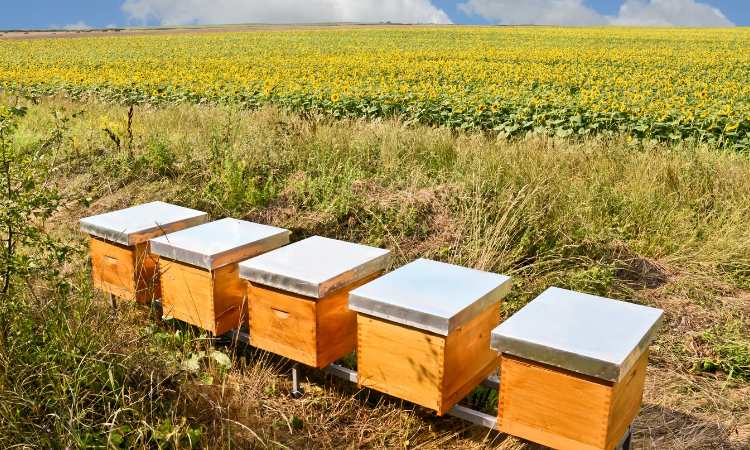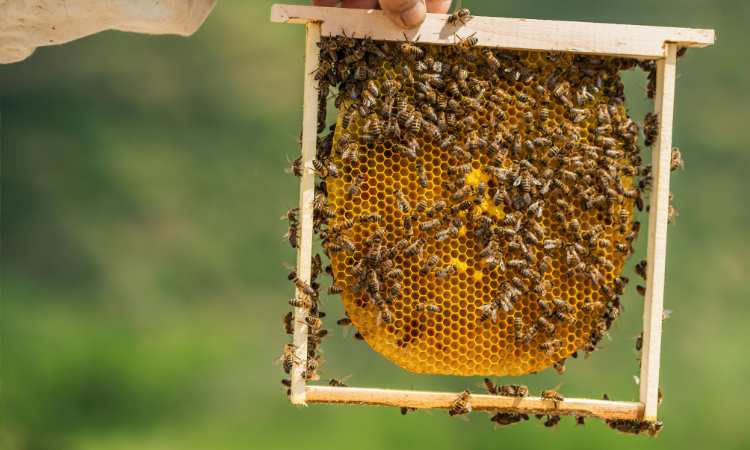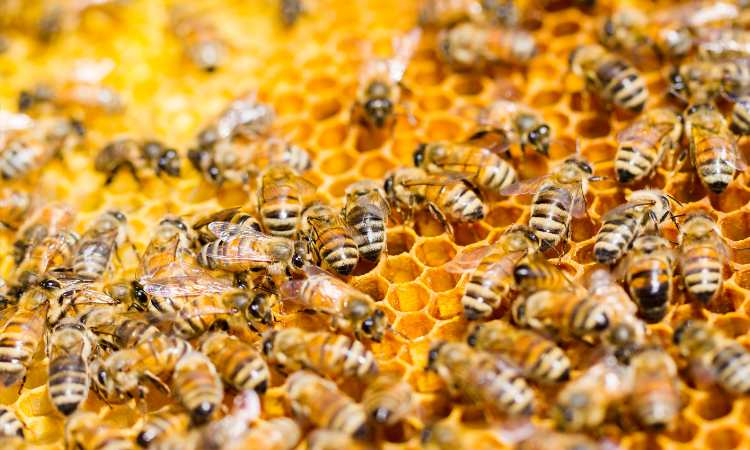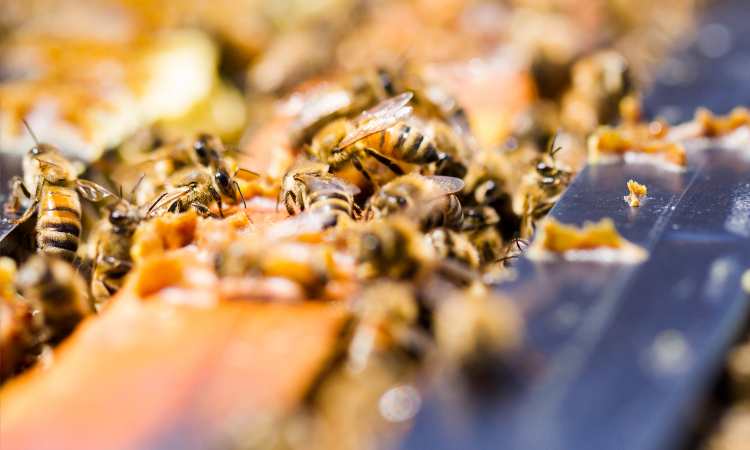Beekeeping is a fulfilling, rewarding hobby that can provide you with sweet honey and other bee products. With the right knowledge, you too can become an expert beekeeper in no time. In this article, we will teach you everything you need to know about how to get started beekeeping, from what equipment you need to where to find bees. We’ll also discuss common mistakes to avoid, so you can ensure your hives will be healthy and productive for years to come.
Why beekeeping?
Beekeeping, also known as apiculture, is the practice of keeping and managing honey bee colonies for the production of honey, beeswax, and other products such as pollen and royal jelly. It is a fascinating and rewarding hobby that has a long history dating back to ancient civilizations.
One of the main reasons people choose to become beekeepers is for the delicious and nutrient-rich honey produced by bees. Honey is a natural sweetener that has been used for centuries in cooking and baking, as well as for its medicinal properties. In addition to honey, bees also produce beeswax, which is used in the production of candles, cosmetics, and other products.
Another reason people become beekeepers is to help support the environment. Honey bees are essential pollinators, meaning they help to pollinate plants and flowers, which in turn helps to produce the fruits and vegetables we eat. Without bees, our food supply would be greatly diminished.

Getting started with beekeeping
Before getting started with beekeeping, it is important to do your research and understand the responsibilities and challenges involved. Here are some key considerations to keep in mind:
- Choose the right location: Bees need a safe and suitable location to build their hive. Look for a sunny spot with a water source nearby, as bees need access to water to survive. It is also important to ensure that the location is protected from strong winds and other potential hazards.
- Understand the equipment and supplies needed: Some of the basic supplies you will need as a beekeeper include a bee suit or protective clothing, a hive tool, a smoker, and a bee brush. You will also need to purchase or build a hive, which can be made of wood or plastic.
- Learn about the different types of bees: There are several different species of bees, but the most common one kept by beekeepers is the European honey bee (Apis mellifera). These bees are known for their ability to produce large amounts of honey and are relatively easy to manage. Other species of bees that are commonly kept include the African honey bee and the Russian honey bee.
- Understand the life cycle of bees: Bees have a complex life cycle, with different roles and responsibilities within the hive. The queen bee is the most important member of the hive, as she is responsible for laying eggs and producing offspring. The worker bees, which are all female, are responsible for gathering nectar and pollen, building the hive, and taking care of the young bees. The drones, which are male bees, do not have any responsibilities within the hive and their main function is to mate with queens from other hives.
- Know how to handle bees safely: Beekeeping can be a rewarding hobby, but it is important to take the necessary precautions to protect yourself and the bees. Wear protective clothing, such as a bee suit, to minimize the risk of being stung. Use a smoker to calm the bees and make it easier to work with them. Always handle the bees gently and with respect, as rough handling can stress the bees and lead to problems within the hive.
- Learn about bee diseases and pests: Like any other animal, bees can be prone to diseases and pests. Some common bee diseases include American foulbrood, European foulbrood, and chalkbrood. Pests that can affect bees include mites, wax moths, and small hive beetles. It is important to regularly inspect your hive and take steps to prevent and treat these issues if they arise.
- Understand the importance of honey production: Honey is one of the main products produced by bees, and it is important to understand the process of honey production and how to harvest it. Bees gather nectar from flowers and bring it back to the hive, where they use it to make honey.

Finding The Right Location For Your Beehive
Finding the right location for your beehive is an important consideration for any beekeeper. The location you choose will have a significant impact on the health and success of your bees, as well as the quality of the honey they produce. Here are some key factors to consider when determining the proper place to put your beehive:
- Sun exposure: Bees need plenty of sunlight to thrive, so it is important to choose a location that gets plenty of sun. Aim for a spot that gets at least six hours of direct sunlight per day.
- Water source: Bees need access to water to survive, so it is important to locate your hive near a source of water. This can be a pond, lake, or even a birdbath. Just be sure to keep the water clean and free of chemicals to ensure the health of your bees.
- Protection from the elements: Choose a location that is protected from strong winds, heavy rain, and extreme temperatures. Bees are sensitive to these conditions and can become stressed if exposed to them for long periods of time.
- Distance from other hives: If you are planning to keep multiple hives, it is important to space them out to avoid competition for resources. Aim for a distance of at least 50 feet between hives.
- Accessibility: Consider the ease of access to your hive when choosing a location. You will need to regularly check on your bees and harvest the honey, so it is important to choose a spot that is easy to get to.
- Safety: Make sure the location you choose is safe for both you and the bees. Avoid placing the hive near areas where there is a lot of foot traffic or near areas where children or pets play.
- Legal considerations: Check with your local ordinances and regulations to make sure it is legal to keep bees in your area. Some cities and towns have specific rules regarding where hives can be placed and how many hives are allowed.
By taking these factors into consideration, you can find the perfect location for your beehive and ensure the health and success of your bees.

The Equipment and Supplies Needed for Beekeeping
Starting a beekeeping hobby or business requires a variety of equipment and supplies to keep your bees healthy and productive. Here is a list of some of the basic items you will need to get started:
- Hive: The hive is where your bees will live and build their honeycomb. There are several types of hives to choose from, including Langstroth hives, top-bar hives, and Warre hives. Each type has its own unique features and benefits, so it is important to do your research and choose the one that is right for you.
- Bees: You will need to purchase bees to populate your hive. You can order bees online or purchase them from a local beekeeping supplier. When choosing bees, consider the species and the age of the queen bee, as well as the overall health of the hive.
- Protective clothing: As a beekeeper, you will need to protect yourself from bee stings by wearing protective clothing. This includes a bee suit or jacket, gloves, and a hat with a veil.
- Hive tool: A hive tool is an essential tool for any beekeeper. It is used to pry open the hive, scrape off wax and propolis, and generally manipulate the hive.
- Smoker: A smoker is a tool used to calm the bees and make it easier to work with them. It works by releasing a stream of smoke, which masks the alarm pheromones released by the bees when they sense danger.
- Bee brush: A bee brush is a gentle tool used to remove bees from the hive or to transfer them from one location to another. It is made of soft bristles and is used to gently sweep the bees off of frames or other surfaces.
- Feeder: During times when there is a shortage of nectar and pollen, you may need to provide your bees with supplementary food. There are several types of feeders available, including frame feeders, entrance feeders, and top feeders.
- Extractor: An extractor is a tool used to remove the honey from the comb. There are several types of extractors available, including hand-crank extractors and electric extractors.
- Bottles: Once you have extracted the honey from the comb, you will need to store it in bottles or jars. There are many types of bottles and jars to choose from, including glass, plastic, and metal.
By investing in the right equipment and supplies, you can ensure the success of your beekeeping venture and produce high-quality honey and other products. As you gain more experience, you may find that you need additional equipment and supplies to meet the needs of your hive.

Different Types of Bees Commonly Used in Beekeeping
There are several different species of bees that are commonly used in beekeeping, each with its own unique characteristics and traits. Here are some of the most common types of bees found in hives around the world:
- European honey bee (Apis mellifera): This is the most widely kept species of bees for beekeeping and is native to Europe, Africa, and parts of Asia. European honey bees are known for their ability to produce large amounts of honey and are relatively easy to manage. They are also gentle and non-aggressive, making them a popular choice for new beekeepers.
- African honey bee (Apis mellifera scutellata): This species of bees is native to Africa and is known for its ability to survive in harsh environments. African honey bees are known for their high levels of productivity and are often used in commercial beekeeping operations. They are also more aggressive than European honey bees and can be more difficult to manage.
- Russian honey bee (Apis mellifera mellifera): This species of bees is native to Russia and is known for its ability to survive cold winters. Russian honey bees are also less aggressive than other species and are generally easy to work with. They are a popular choice for beekeepers in colder climates.
- Italian honey bee (Apis mellifera ligustica): This species of bees is native to Italy and is known for its high levels of productivity and gentle nature. Italian honey bees are a popular choice for beekeepers in warm climates.
- Carniolan honey bee (Apis mellifera carnica): This species of bees is native to Slovenia and is known for its gentle nature and ability to survive in cold climates. Carniolan honey bees are a popular choice for beekeepers in colder climates.
Each species of bees has its own unique characteristics and traits, so it is important to do your research and choose the one that is right for your specific needs and location. By choosing the right bees for your hive, you can ensure the success of your beekeeping venture and produce high-quality honey and other products.
Understanding The Life Cycle of Bees Used in Beekeeping
The life cycle of bees is an essential aspect of beekeeping and understanding it can help you better care for your hive. Here is a brief overview of the life cycle of bees:
- Egg: The life cycle of a bee begins with the egg, which is laid by the queen bee. The eggs are small, oval-shaped, and white in color. They are laid in cells within the hive and are incubated for about three days before hatching.
- Larva: When the eggs hatch, they emerge as larvae, which are small, worm-like creatures. The larvae are fed a special diet of pollen and nectar, known as “bee bread,” by the worker bees. After about six days, the larvae spin a cocoon and begin the pupal stage.
- Pupa: During the pupal stage, the larvae transform into adult bees. This process takes about 10 days for worker bees and about 14 days for drones (male bees).
- Adult: When the pupal stage is complete, the bees emerge as adults. Worker bees are responsible for gathering nectar and pollen, building the hive, and taking care of the young bees. Drones, on the other hand, do not have any responsibilities within the hive and their main function is to mate with queens from other hives.
- Queen: The queen bee is the most important member of the hive, as she is responsible for laying eggs and producing offspring. The queen is larger than the other bees and has a longer lifespan, often living for several years.
- Drones: Drones are male bees that are responsible for fertilizing the eggs of the queen. They do not have any responsibilities within the hive and their main function is to mate with queens from other hives.
- Worker bees: Worker bees are all female and are responsible for gathering nectar and pollen, building the hive, and taking care of the young bees. They are the most numerous bees in the hive and play a vital role in the success of the hive.
By understanding the life cycle of bees, you can better understand the needs of your hive and ensure the health and success of your bees.
Knowing How To Handle Bees Safely Is Important in Beekeeping
As a beekeeper, it is important to handle your bees safely to minimize the risk of being stung and to ensure the health and well-being of your hive. Here are some tips for handling bees safely:
- Wear protective clothing: To protect yourself from bee stings, it is essential to wear protective clothing when working with your bees. This includes a bee suit or jacket, gloves, and a hat with a veil. Make sure your clothing fits properly and covers your skin to reduce the risk of being stung.
- Use a smoker: A smoker is a tool used to calm the bees and make it easier to work with them. It works by releasing a stream of smoke, which masks the alarm pheromones released by the bees when they sense danger. Use the smoker sparingly and avoid oversmoking the hive, as this can stress the bees and lead to problems within the hive.
- Handle the bees gently: Always handle the bees gently and with respect, as rough handling can stress the bees and lead to problems within the hive. Use a bee brush to gently remove bees from the hive or to transfer them from one location to another. Avoid squeezing or squashing the bees, as this can damage them and lead to injuries.
- Work in the early morning or late afternoon: Bees are less active in the early morning or late afternoon, so these are the best times to work with them. Avoid working with your bees during the heat of the day, as this can stress the bees and make them more prone to stinging.
- Be aware of your surroundings: Always be aware of your surroundings when working with your bees. Avoid working near areas where there is a lot of foot traffic or near areas where children or pets play. This will help to minimize the risk of being stung and keep your bees safe.
By following these tips, you can handle your bees safely and ensure the health and well-being of your hive.
Learn About Bee Diseases and Pests Found in Beekeeping
Like any other animal, bees can be prone to diseases and pests that can affect their health and productivity. As a beekeeper, it is important to understand the common diseases and pests that can affect your bees and take steps to prevent and treat them. Here is a brief overview of some of the most common bee diseases and pests:
- American foulbrood (AFB): AFB is a bacterial disease that affects the larvae of bees and is caused by the bacterium Paenibacillus larvae. Symptoms of AFB include sunken or collapsed larval cells, a foul smell, and a brown or yellowish color. AFB is highly contagious and can spread quickly through a hive, leading to high mortality rates. To prevent AFB, it is important to use good hygiene practices and to destroy infected hives.
- European foulbrood (EFB): EFB is a bacterial disease that affects the larvae of bees and is caused by the bacterium Melissococcus plutonius. Symptoms of EFB include sunken or collapsed larval cells, a foul smell, and a yellowish or brownish color. EFB is less contagious than AFB, but it can still lead to high mortality rates if left untreated. To prevent EFB, it is important to use good hygiene practices and to destroy infected hives.
- Chalkbrood: Chalkbrood is a fungal disease that affects the larvae of bees and is caused by the fungus Ascosphaera apis. Symptoms of chalkbrood include sunken or collapsed larval cells, a white or chalky appearance, and a foul smell. Chalkbrood can be prevented by maintaining good hygiene practices and ensuring that the hive is well ventilated.
- Mites: Mites are tiny parasites that can infest a hive and drain the bees of their blood. The most common mite that affects bees is the varroa mite. Symptoms of a mite infestation include a decline in the population of the hive, deformed wings, and a reduction in the amount of honey produced. To prevent and treat mite infestations, it is important to regularly inspect your hive and use approved treatments if necessary.
- Wax moths: Wax moths are small, moth-like insects that can infest a hive and damage the comb. Symptoms of a wax moth infestation include holes in the comb, frass (insect droppings), and a reduction in the population of the hive. To prevent and treat wax moth infestations, it is important to regularly inspect your hive and remove any damaged comb.
- Small hive beetles: Small hive beetles are small, beetle-like insects that can infest a hive and damage the comb. Symptoms of a small hive beetle infestation include a decline in the population of the hive, damage to the comb, and a reduction in the amount of honey produced. To prevent and treat small hive beetle infestations, it is important to regularly inspect your hive and use approved treatments if necessary.
By understanding the common diseases and pests that can affect your bees, you can take steps to prevent and treat them and ensure the health and success of your hive.
The Importance of Honey Production in Beekeeping
Honey production is an important aspect of beekeeping, as it is the primary source of income for many beekeepers. Honey is a versatile and highly sought-after product that is used in a wide variety of food and non-food products. In addition to its economic value, honey also has a number of health benefits and is a natural sweetener that is widely used in cooking and baking.
There are several factors that can affect the production of honey, including the type of bees, the availability of nectar and pollen, and the overall health of the hive. In order to maximize honey production, it is important to choose the right bees for your location, provide supplementary food if necessary, and take steps to prevent and treat diseases and pests.
Honey production is also important for the environment, as bees play a vital role in the pollination of plants. By providing a source of nectar and pollen, bees help to pollinate a wide variety of crops, including fruits, vegetables, and nuts. This process is essential for the production of food and has a significant impact on the overall health of the ecosystem.
In addition to its economic and environmental benefits, honey production is also a rewarding and enjoyable hobby that can bring people closer to nature. By becoming a beekeeper, you can not only produce high-quality honey and other products, but also contribute to the conservation of bees and the overall health of the environment.
Overall, the production of honey is an important aspect of beekeeping that offers numerous benefits to beekeepers, the environment, and consumers. By understanding the importance of honey production, you can ensure the success of your beekeeping venture and make a positive contribution to the world.
In conclusion, beekeeping is a rewarding and fascinating hobby that can bring joy to both the environment and the beekeeper. Getting started can be intimidating, but with the right resources, knowledge, and supplies, you can become a successful beekeeper. Understanding the basics of what equipment you need and how to maintain your hives are key steps in becoming an efficient beekeeper. Plus, there is a wealth of support available from experienced beekeepers and organizations that can help every step of the way.

Hi – I’m Erika, the head writer and expert beekeeper here at Just Beekeeping! I am a backyard beekeeper and proud member of the American Beekeeping Federation (ABF) and the Central Indiana Beekeepers Association. In addition, I am an educator with advanced degrees from UC-Berkeley and the University of Southern California (USC). I use my expertise to help others learn about beekeeping, and I am an advocate for all subjects bee related!